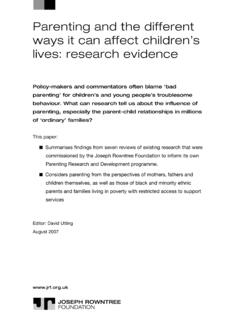Transcription of NUTRITION IN THE FIRST 1,000 DAYS
1 1,000 DAYS - NUTRITION IN THE FIRST 1,000 DAYS: A Foundation for Brain Development and Learning1A Foundation for Brain Development and LearningNUTRITION IN THE FIRST 1,000 DAYSThe 1,000 days between a woman s pregnancy and her child s second birthday offer a brief but critical window of opportunity to shape a child s development. It is a time of both tremendous potential and enormous vulnerability. How well or how poorly a child fares during his FIRST 1,000 days can mean the difference between a thriving future and one characterized by struggle. New research in to the fields of neuroscience and early childhood development is shedding light into how our brains develop and how our capacities are either nourished or thwarted. Together with stable, responsive relationships with caregivers and safe and nurturing environments, NUTRITION during a child s FIRST 1,000 days builds the foundation for a child s development. When one or more of these supports is absent, a child s physical, social, emotional and cognitive development can suffer, resulting in the loss of opportunities that are every child s birthright.
2 Good NUTRITION during pregnancy and early childhood plays a foundational role in enabling a child to grow, learn and thrive. In a real sense, NUTRITION provides the fuel that drives a child s early development. During the FIRST 1,000 days, the brain grows more quickly than at any other time in a person s life and a child needs the right nutrients at the right time to feed her brain s rapid development. There are three crucial stages in the FIRST 1,000 days: pregnancy, infancy and toddlerhood. At each stage during the 1,000 day window, the developing brain is vulnerable to poor NUTRITION either through the absence of key nutrients required for proper cognitive functioning and neural connections and/or through the toxic stress experienced by a young child whose family has experienced prolonged or acute adversity caused by food insecurity. 1,000 DAYS - NUTRITION IN THE FIRST 1,000 DAYS: A Foundation for Brain Development and Learning2 THE DEVELOPMENTAL COURSE OF THE HUMAN BRAINThe effects of poor NUTRITION on a child s brain development can be profound and long-lasting which is why it is critical to understand how to ensure children get the NUTRITION they need to thrive throughout their FIRST 1,000 days.
3 In this brief, we examine how NUTRITION shapes a child s brain development during each of the three stages. PREGNANCYD uring pregnancy, the human brain develops at an astonishing speed. It begins to grow very early on in pregnancy: the neural tube forms just 16 days after conception and by 7 months a child s brain takes on a form that resembles that of an adult At the 4th week of pregnancy, the brain has an estimated 10,000 cells by the 24th week, it contains 10 NUTRITION that a baby gets from his mother through her diet is the indispensable fuel that drives much of this incredible transformation. Starting in pregnancy, nutrients are needed for the creation of new neurons, the cells that form the tissue that transmits and receives nervous impulses, and for the covering of axons with myelin, the fatty matter that accelerates the speed of nerve impulses traveling from one cell to another.
4 Nutrients also fuel the formation of synapses, which provide the basis for learning ability. When a mother lacks adequate calories, protein, fatty acids or key micronutrients in her pregnancy, these vital neurodevelopmental processes can be nutrients play an important role in building the brain during pregnancy. These include iron, protein, copper, folate, zinc, iodine and certain ,4 Zinc, in particular, supports the development of the autonomic nervous system, the hippocampus and the cerebellum, while iron impacts the myelination of the nerve fibers which affects the brain s processing speed. Long-chain polyunsaturated fatty acids typically found in breast milk, fish oils and egg yolks play a central role in the healthy development and functioning of the brain and the ,000 DAYS - NUTRITION IN THE FIRST 1,000 DAYS: A Foundation for Brain Development and Learning3 BREASTMILK IS NATURE S THE 4TH WEEK OF PREGNANCY, THE BRAIN HAS AN ESTIMATED 10,000 CELLS BY THE 24TH WEEK, IT CONTAINS 10 mother s diet and her nutrient stores are the only source of NUTRITION for the developing baby.
5 When a pregnant woman does not get the calories, key nutrients or essential proteins she needs to support her baby s development, her baby is placed at risk for developmental delays, birth defects and cognitive deficits. For example, folate is critical to the early development of the brain and spine. When a woman lacks sufficient folic acid before becoming pregnant and in the early weeks of her pregnancy, the development of the neural tube can go awry, leading to birth defects of the brain and spine (anencephaly and spina bifida) that can cause death or lifelong is also a time of remarkable brain development and growth, which is primarily fueled by the nourishment a baby receives. During this time, the brain is developing motor functions such as balance, coordination and posture. This is also a critical time for hippocampal-prefrontal connections which enable the child to create and retrieve it comes to brain development, breastmilk is the ultimate superfood.
6 Breastmilk contains a variety of nutrients, growth factors and hormones that are vital for a child s early brain development. Because breastmilk is a living substance with unique components that cannot be replicated in infant formula, its impact on brain development is unparalleled. Using neuroimaging technology, scientists have been able to see that children who were exclusively breastfed (no food or liquids other than breastmilk) for at least 3 months had increased white matter development in several brain regions, associated with executive functioning, planning, social-emotional functioning and recent study followed pre-term infants from birth until later childhood and found that children who were 1,000 DAYS - NUTRITION IN THE FIRST 1,000 DAYS: A Foundation for Brain Development and Learning4A CHILD S BRAIN MAKES MORE THAN 1 MILLION NEURAL CONNECTIONS EVERY more breastmilk within the FIRST 28 days of life had larger volumes of certain regions of the brain and by age 7, had higher IQs and better scores in reading, mathematics, working memory and motor function all income levels, breastfeeding is consistently associated with higher performance on intelligence tests among children and adolescents.
7 In particular, breastfeeding for 12 months or more is associated with a 3-point increase in IQ as well as higher educational attainment and It appears that both the breastmilk itself as well as the experience of breastfeeding contributes to the healthy development of a child s brain. Babies brains are shaped not only by the quality of the NUTRITION they get but also by the quality of the experiences and interactions they have with caregivers. Because the physical act of breastfeeding involves a great deal of mother-child interaction and nurturing, it plays an important role in strengthening a baby s sensory and emotional circuitry, which are critical for both cognitive and socio-emotional too few children in the are benefiting from breastfeeding despite its critical role in brain development. The reasons why women avoid or stop breastfeeding vary, but it is clear from the research that women who want to breastfeed need stronger support from their families, communities, health care providers and EARLY CHILDHOODIn the toddler stage, a child s brain continues to grow and develop at a rapid pace.
8 The speed of a child s neural processing that is, how quickly the brain can interpret and relay information also increases dramatically during early childhood, enabling theyoung brain to perform more complex tasks. During this time, a young child s brain is busy forming synapses the connections that allow neurons (brain cells) to communicate with one another. Throughout early childhood, a child creates synapses at a rate faster than at any other time in her life and creates more of them than she will need. In these early years of a child s life, more than 1 million new neural connections are formed every In fact, a toddler s brain has up to twice as many synapses as it will have in adulthood. The excess of synapses produced by a child s brain during this stage makes the brain highly responsive to external input and gives it the ability to shape itself. This ability known as neuroplasticity enables human beings to adapt to changing environments and circumstances.
9 Importantly, in the 2nd year of a child s life, synapses in the brain s language areas are developing and becoming more interconnected, leading to a surge in a child s language provides the fuel for much of the extraordinary brain development that takes place in early childhood, 1,000 DAYS - NUTRITION IN THE FIRST 1,000 DAYS: A Foundation for Brain Development and Learning5and NUTRITION during this period remains critically important. In particular, protein, iron, zinc and iodine are essential to the toddler s rapidly developing brain. Iron plays a significant role in brain development throughout the FIRST 1,000 days, and the damage done by iron deficiency in pregnancy and the FIRST 2 years of a child s life can be irreversible. Children ages 1 to 3 require 7mg13 of iron daily, and unless toddlers are fed meat or other iron-rich foods, they are unlikely to consume enough iron.
10 Iron deficiency in infants and toddlers can lead to impaired learning and social-emotional behavior, including less social interaction and alertness, increased irritability, wariness and inhibited behavior, and less interest in play. This, in turn, can reduce the amount of attention and interaction given by caregivers and teachers, further contributing to poorer developmental outcomes. Iron deficiency also appears to affect the brain s neurochemistry, and studies have shown that early iron deficiency is associated with higher levels of anxiety and depression later in life with impacts for consequent job ,15,16,17 While poor NUTRITION is toxic to the healthy development of young children, other factors in children s environments can also negatively affect how the brain develops. The plasticity of the young child s brain makes it particularly sensitive to elevated levels of stress hormones in ways that can harm its developing For example, continued exposure to high levels of stress, such as that experienced by food insecure families, can alter a young child s stress-response system, leading to heightened arousal, which increases the risk of stress-related disorders later in ,20 All of us have a stake in whether children get a strong start to life.

